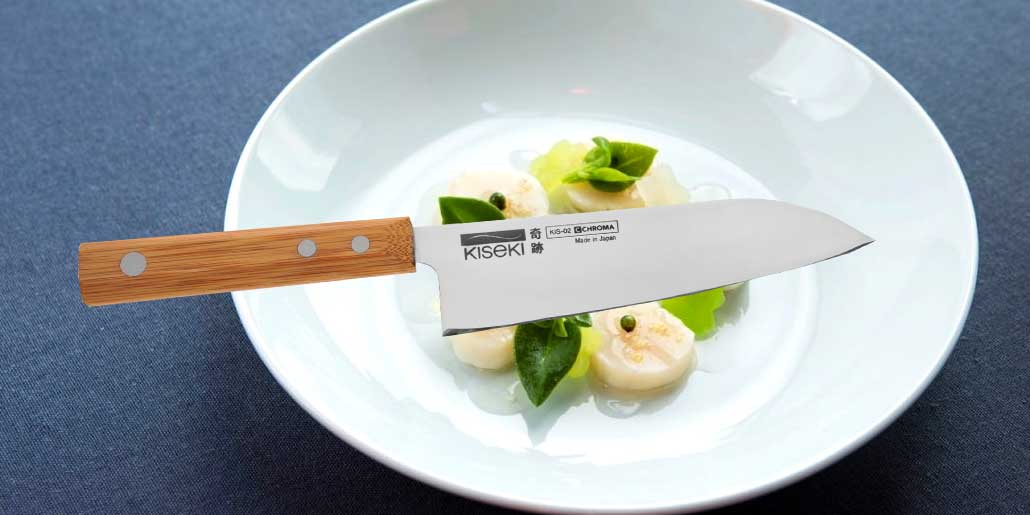CHROMA KISEKI knife
The almost perfect cutting miracle

We have been selling high-quality and professional kitchen knives, sharpening stones and accessories since 1986. We specialize in very sharp and sharp V-grind blades, as well as easy-to-sharpen knives. I
CHROMA KISEKI knife - the almost perfect cutting miracle
Bionics: nature is the role model - in search of the ideal kitchen knife
Since time immemorial, knife manufacturers have been looking for the perfect knife: one that is very sharp and stays sharp forever, easy to care for, and easy and good to hold. CHROMA comes very close to this ideal with the Kiseki. Kiseki is Japanese and means miracle! You will understand, if you have worked with your Kiseki!
CHROMA`s new Kiseki three-piece chef`s knife series was developed by experienced Japanese engineers for CHROMA.
The scientists copied nature. This is called bionics. The incisors of rodents are made of two different materials: the largest part of the tooth consists of the relatively soft dentin. It is as soft as aluminum. The front of the tooth, on the other hand, covers a thin layer of extremely hard tooth enamel. Enamel is the hardest material in the animal kingdom, with it you can even carve aluminum. It`s as tough as structural steel. When gnawing, the soft dentin wears off faster than the hard enamel. This always creates a razor-sharp edge of hard enamel at the junction of these two layers.
The engineers copied this condition by blending a metal alloy, which is clearly visible on the left side of the knife, and much harder than the already hard enamel, with the blade.
This very expensive special alloy was originally invented for aerospace and protects under other jet engines of rockets from corrosion in space. The 59 ° HRC hardened base blade, a high-grade molybdenum-vanadium stainless steel, is harder than dentin. So the knife stays sharp for an extremely long time, much longer than rodent teeth, if they would not regrow.
In rodents, enamel and dentin grow. Renewable metals are not yet available. Therefore, after some time - due to the wear over years - the Kiseki knife dull. However, it can be sanded extremely sharply by grinding on one side of the grindstone.
With the knife handle, the developers of the Kiseki series have taken a different approach. They interviewed many good chefs in Japan and watched how they work with the knife. In addition, they interviewed amateur cooks. Pretty soon it turned out that there was a great interest in a wooden handle, which should be firmly in the hand and unlike the traditional Honoki handles no longer needs to be replaced.
The researchers therefore adopted the proven Western concept of rivets that hold the handle and modified the handle of traditional Japanese knives. The result was the novel Hachikakukei no grip, an octagonal (octagonal) shape that is particularly secure in each hand. Now the question arose of the best wood. At a conference, the engineers met colleagues from Lexus, the luxury car manufacturer. They raved about a novel bamboo laminate, which feels great and is very durable. Lexus builds this in its own bamboo forest. Since the Lexus people welcomed the idea of a knife handle from their material, they now deliver this high-quality material, so that the handle could be perfected. Bamboo is a renewable resource with good sustainability.
It may not be the perfect knife yet, as long as there is no renewable metal, it probably will not exist. It comes to him but in our view already very close. Also because you can sharpen it yourself so fast and easily and it`s so sharp right from the start.
The bionic concept was already tried by various manufacturers, but you could never regrind these knives yourself, but had to send them in for service. The CHROMA Kiseki can be easily reground with a chroma stone, but only on the side with logo. On the Kiseki side with the hard Kiseki stripe you must not sand, otherwise you will simply sand away the Kiseki effect. Then you would only have a normal good knife without Kiseki.
With a CHROMA stone - we recommend the ST-1000 - regrind on one side. Carefully remove the burr on the coated side. Watch our video on www.kochmesser.de.
Difference to other blade materials: Steel blunts relatively quickly depending on the quality. A very good Japanese knife, such as the haiku loses its sharpness after about 150 standardized test runs (CATRA TEST) - which already marks a very good value. A good ceramic knife manages about 2,800 runs, but is very fragile and difficult to grind by a professional grinder. The Kiseki still cuts well over 4,500 test runs and can at any time, without much effort, be brought back to its original sharpness.
Kiseki knives are designed for right-handed people, as well as unilaterally ground Japanese sashimi knives.
copyright text: kochmesser.de
-

KIS-01 Chroma Kiseki Petty, universal knife, 11 cm
1 pc € 159,65 * (€ 159,65 / piece)
NOT AVAILABLE Currently not available. When this product will be available is not known. Please also note the information on payment and shipping.item number: 24878
Currently not available. When this product will be available is not known. Please also note the information on payment and shipping.item number: 24878







